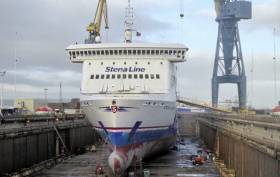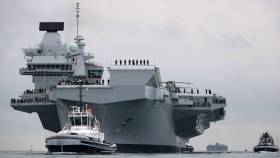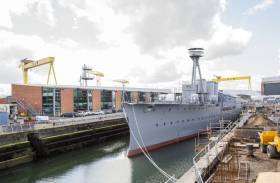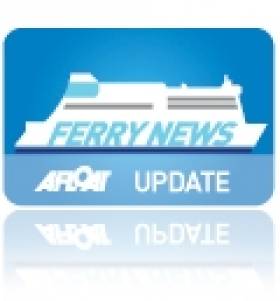Displaying items by tag: H&W
Harland & Wolff Sees Valuers Aboard For Sale
#belfast- Business advisers are carrying out a valuation of Belfast's Harland & Wolff ahead of a likely disposal by its parent company this year, the Independent can reveal.
Accountants have been sent in to carry out the work to establish the asking price of Harland & Wolff Heavy Industries Ltd, which is to be sold as part of restructuring by Norwegian parent company Fred Olsen Energy.
Harland & Wolff covers two sites on Queen's Island in east Belfast, including the Belfast Repair Dock where some ship work is still carried out, including the current refit of some Stena Line ferries.
Click here for more on this development.
Operator Stena Turns to H&W for £5m Fleet Upgrade
#ferries - Work has begun on ferries from Stena Line which involves a £5 million refit programme of its local fleet at Belfast's Harland & Wolff shipyard.
The 10-week upgrade schedule reports the Irish News, will see five Stena vessels dry docked consecutively to facilitate refurbishment and maintenance works.
The move continues the carrier's long-standing relationship with H&W, and will represent a considerable boost to the supply chain.
For comments made from the ferry operator and the shipyard, click here.
Site of Harland & Wolff Must Not Become Apartments, Says UUP's Lord Empey
#BelfastLough - Harland and Wolff shipyards in Belfast, must be maintained for industrial use and not sold off to property developers, Lord Empey has said.
As The Belfast Telegraph writes, the former UUP leader was speaking after it emerged last week that the historic Belfast company was up for sale as its Norwegian parent company Fred Olsen carries out a major restructuring.
The former shipbuilder behind the Titanic has diversified into renewable energy installations since the last ship sailed out of its famous yard in 2003.
The decline of shipbuilding has also been marked by a steady fall in employee numbers from as many as 30,000 in the 1930s to around 100 today.
Harland and Wolff covers two sites on Queen's Island in east Belfast, including the Belfast Repair Dock where some ship work is still carried out.
There is also the main building dock and manufacturing halls where the famous Samson and Goliath gantry cranes operate.
The combined surface area of the sites is nearly 90 acres.
Former Northern Ireland Enterprise Minister Lord Empey has said that he fears the site may now fall into the hands of property developers.
For further comments by the former politician, click here.
#BelfastLough - Fred. Olsen Energy, the Norwegian drillship,rig operator and owners of the yard that built RMS Titanic, is considering a debt and equity restructuring that would almost wipe out the value of its current shares, the company said.
With debt and liabilities of more than $840 million at the end of June, Reuters reports that Fred. Olsen last month stopped paying its creditors to preserve liquidity, making it the latest victim of a slow recovery in the oil and gas exploration sector.
The owner of seven drillships and rigs, as well as Belfast’s Harland & Wolff yard, has now received indicative, non-binding proposals from equity investors valuing its current shares and bonds at just $10 million, it said in a statement.
The company’s largest owner, Bonheur, which holds a 51.9 percent stake, separately said it had not decided whether to take part in the proposed refinancing.
Click HERE to read more on H&W.
Harland & Wolff Secures Contracts And Creating Jobs
#powerfromthesea - Harland and Wolff, the former giant of shipbuilding in Belfast is meeting demands from new contracts and is currently hiring a range of staff, it has emerged.
As the Belfast Telegraph writes, the marine and engineering firm is hiring between 10 and 20 workers across a range of fields, as it ramps up fresh wind farm projects.
It's hiring a range of new posts to meet work demand for new projects which it's undertaking over the next few years.
Jobs include tower crane operators, pipe fitters and fabricators, planners, structural engineers, accountant and surveyors and welders.
It's understood the new posts relate to the company winning a major contract at the end of last year, to build 24 huge steel foundation jackets for an offshore wind farm company.
The project is expected to last for around 18 months.
Standing at 65 metres tall, and weighing more than 845 tonnes, the three-legged steel jacket structures are almost as prominent on the Belfast skyline as the famous Samson and Goliath cranes. At the time, the firm said the work could support 200 jobs.
To read more these developments at the Queens Island facility, click here.
New £1bn Investment Warship Building Plan - Harland & Wolff Hopeful
#belfastlough- A multimillion-pound fleet of new warships writes The Belfast Telegraph could be built in blocks across several shipyards in Britain, including Belfast, the Defence Secretary has announced.
While tender is open for selection for the build, Harland and Wolff are hoping to be involved.
Defence Secretary Michael Fallon said the first batch of new Type 31e frigates would be built with the export market in mind, with the UK shipbuilding industry potentially serving both the Royal Navy and navies of allies and partners.
As part of this approach, the Ministry of Defence (MoD) announced that the first batch of five Type 31e frigates could be built across different shipyards, before being assembled at a central site. Cost would be capped at no more than £250 million each.
A spokesperson from Harland and Wolff said: "Commercially it would be a great success for us. "All the work we do, the benefit has not been seen by they Royal Navy." They added: "It would also mean our commercial fabricators would have the opportunity to work with international partners."
To read much more on the naval newbuilding development, the newspaper has more here.
#HMScaroline - An historic ship with a wartime past that is a modern day Belfast tourist attraction has had its future secured thanks to a major programme of innovative repairs, safety upgrades and improvements.
As the Belfast Telegraph writes, HMS Caroline, the only survivor of the First World War Battle of Jutland, is now nearly ship-shape and Bristol fashion again and ready to reopen to the public, who visited it in their thousands last year.
The ship underwent extensive repairs over the winter and engineers came up with an ingenious solution to the problem of how to make it even safer for visitors.
The National Museum of the Royal Navy said it was one of the most innovative engineering projects seen in Ireland, and it is nearing completion at Alexandra Dock in Belfast.
The ship was fully restored and opened to the public in May 2016 with £15,086,100 backing from the Heritage Lottery Fund and £4,518,000 support from Tourism NI.
But repairs were needed to the hull and they have been carried out by Harland and Wolff Heavy Industries.
At the same time a hugely-complex permanent mooring system to make the ship safe for the public and also to protect it from lateral movements as it floats on the rising and falling tides is now close to completion. For more on the return of the floating tourist attraction, click here.
New Windfarm Deal for Harland & Wolff Secures 80 Jobs
#NewContract - A new contract for Harland & Wolff is to provide parts for an off-shore windfarm off the coast of Germany — supporting 80 jobs.
The Belfast Telegraph writes that the firm has been chosen by jacket foundation supplier ST3 Offshore to supply suction buckets for DONG Energy’s Borkum Riffgrund 2, which is an an offshore windfarm.
As part of this agreement, H&W will manufacture and export a significant number of suction buckets.
The suction buckets manufactured by H&W will be exported from the UK to ST3’s advanced serial manufacturing plant in Stettin, Poland, for fitting prior to foundation installation.
For more on the contract, click here.
Restoration of Titanic’s Tender SS Nomadic Completed
#TitanicTender – S.S. Nomadic as previously reported on Afloat.ie, is a veteran of two world wars and has a direct link to the luxurious RMS Titanic past, and Charlie Chaplin and Elizabeth Taylor who have been on board the passenger liner tender.
As of today, the last remaining vessel of the White Star Line, will be open for visitors in her dry-dock next to the Titanic Belfast Visitor Centre and close to where she was launched in 1911 at Harland & Wolff.
She was built to ferry first and second class passengers to RMS Titanic from Cherbourg in France, a port too small for what was at that time the largest ship in the world. For more on this the BBC reports.
Afloat.ie adds that another former trans-Atlantic liner tender that served in Cork Harbour, (Titanic's last port of call), the T.S.M.V. Cill Airne ran from Cobh out to the liners during a short career until the early 1970's.
The Dublin-built vessel launched in the early 1960's is now a static restaurant and bar venue and is also open to visitors today and throughout the Dublin Port River Festival (1-3 June).
#STENA SALE SHIP- Irish Sea ferry stalwart Stena Caledonia (1981/12,619grt) has been sold to ASDP Ferry of Indonesia according to Ships Monthly. The vessel remains moored in Belfast awaiting her delivery voyage, which will be the longest ever she is to undertake in her career, writes Jehan Ashmore.
All Stena Line funnel and hull markings of the 31-year old vessel have been painted out and she has been renamed Portlink and re-registered in Jakarta, the capital of Indonesia.
Since late November she stood down following the switch of Scottish ferryport from Stranraer to Cairnryan, where a new £80m Loch Ryan Port ferry terminal is served by two newly introduced and luxuriously refurbished sisters Stena Superfast VII and Stena Superfast VIII. The pair built in Germany in 2001 have successfully been introduced on the new Belfast-Cairnryan route.
Initially the Stena Caledonia was laid-up in Belfast at Albert Quay though in recent months she shifted berths to the former Outfit Quay at Harland & Wolff, ironically this location being very close to the facilities Musgrave Yard, where she built as St. David for Sealink / British Rail.
She became the last vessel to be launched from that particular yard on Queens Island and historically she is significant in that she is the last passenger (including car-ferry) vessel to be built by H&W.































































